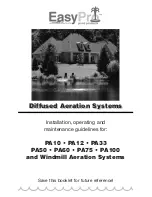
Instruction manual SGS
17
gis
2.4.6
Pressure switch
The pressure switch ensures the discharge of flue gases and the supply of
incoming air during the pre-purge and normal running of the appliance. The
default state of the pressure switch is open. When sufficient pressure difference
is reached, the pressure switch closes. However, in the event of a fault, the
pressure switch is tripped open, and the heating cycle is interrupted. The table
shows the trip point per appliance.
Note
The trip point of the pressure switch is not adjustable.
Pressure switch trip points
2.4.7
Flame probe
To ensure that no gas can flow when there is no combustion, the water heater is
fitted with a flame probe (21). The electronic controller uses this probe to detect the
presence of a flame, by means of ionisation detection. The electronic controller
closes the gas control the instant it detects that there is a gas flow but no flame.
2.5
Safety of the
installation
In addition to the appliance's standard built-in safety monitoring, the appliance
must also be protected by an expansion vessel, expansion valve, pressure
reducing valve, non-return valve and a T&P valve.
The use of an expansion vessel, expansion valve and/or pressure reducing
valve depends on the type of installation: unvented or vented.
2.5.1
Unvented installation
With an unvented installation, an expansion valve valve and expansion vessel
prevent the buildup of excessive pressure in the tank. This prevents damage
being caused to the enamelled coating (in the appliance) or to the tank. A non-
return valve prevents excessive pressure buildup in the water supply system.
This valve also prevents water from flowing backwards from the tank into the
cold water supply system. The pressure reducing valve protects the installation
against an excessively high water supply pressure (> 8 bar). These components
are fitted to the cold water pipe
(3.6 "Water connections, Vented")
.
2.5.2
Vented installation
With a vented installation, excess pressure is taken up by the open cold water
head tank. The height of the head tank determines the working pressure in the
water heater, which may not exceed 8 bar. The installation must also be fitted
with a vent pipe from the hot water pipe, that opens into the cold water tank.
Ideally, the vent pipe should discharge into a separate tundish/drain or
otherwise to the open cold water head tank. The water heater should also be
fitted on the hot water side with a stop valve
(3.7.2 "Hot water side")
.
2.5.3
T&P valve
A T&P valve is only mandatory in an unvented installation. However, A.O. Smith
also recommends the use of a T&P valve in vented installations.
A T&P (Temperature and Pressure Relief) valve monitors the pressure in the
tank and the water temperature at the top of the tank. If the pressure in the tank
becomes excessive (> 10 bar) or the water temperature is too high (> 97°C), the
valve will open. The hot water can now flow out of the tank. Because the
Appliance Closing pressure difference Opening pressure difference
SGS 80
> 1005 Pa
< 975 Pa
SGS 100
> 1145 Pa
< 1115 Pa
Summary of Contents for SGS - 100
Page 1: ...80 100 Installation User and Service Manual Installation User and Service Manual...
Page 2: ...www aosmithinternational com your installer...
Page 4: ...4 Instruction manual SGS gis...
Page 8: ...Table of contents 8 Instruction manual SGS...
Page 12: ...Introduction 12 Instruction manual SGS 1 gis...
Page 44: ...Installation 44 Instruction manual SGS 3 is...
Page 62: ...Shutting down 62 Instruction manual SGS 10 gis...
Page 92: ...Maintenance frequency 92 Instruction manual SGS 14 is...
Page 101: ...Instruction manual SGS 101 is...
Page 106: ...Appendices 106 Instruction manual SGS 17 is...
















































